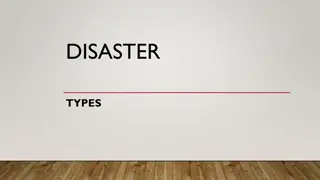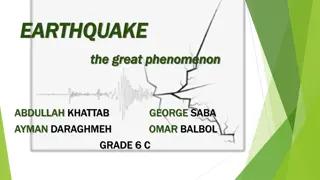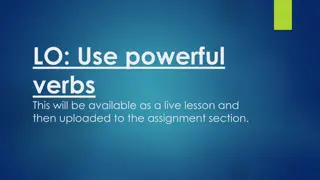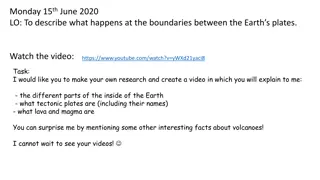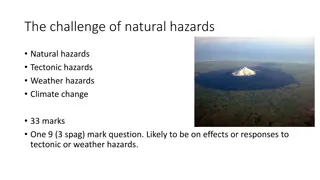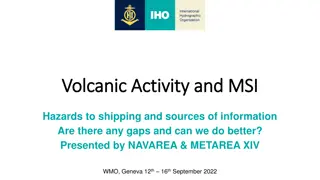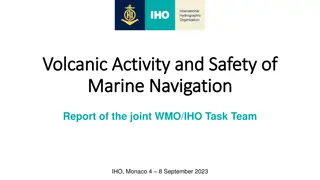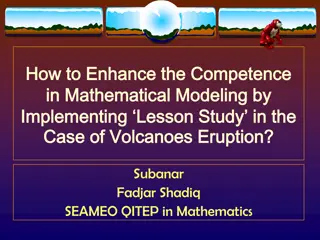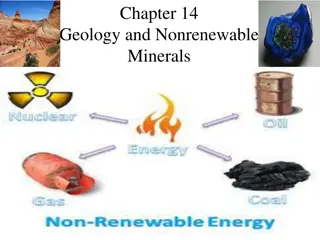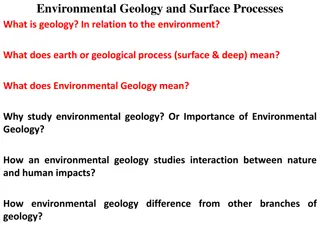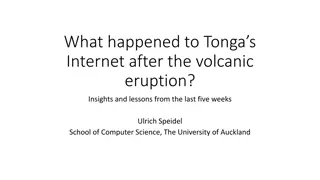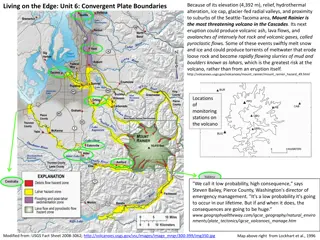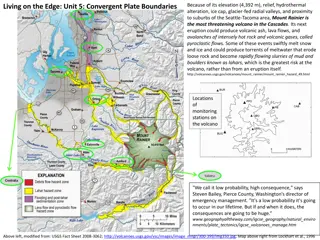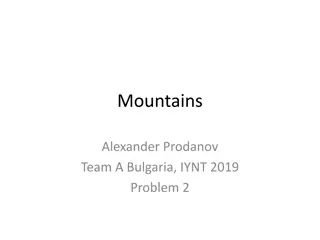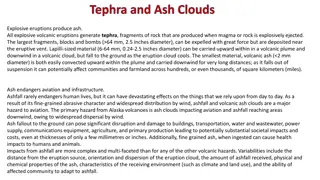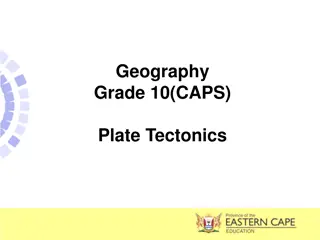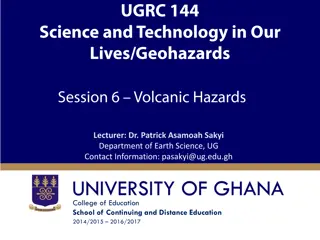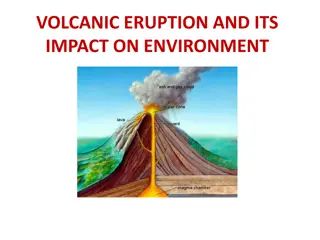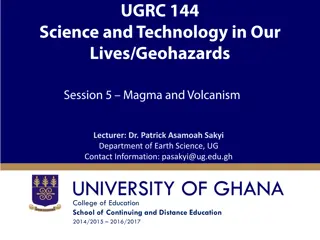Understanding Volcanic Eruptions: Key Terminology and Processes
Volcanic eruptions are caused by the release of pressure inside the Earth, leading to the expulsion of magma through volcanic vents. This process results in the formation of cone-shaped mountains or hills known as volcanoes. The magma, which originates from the asthenosphere, rises through cracks in the Earth's crust and, when reaching the surface, solidifies to create new landforms. Legends and myths surrounding volcanic activity, such as Pele in Hawaii, add cultural significance to these natural phenomena.
Download Presentation

Please find below an Image/Link to download the presentation.
The content on the website is provided AS IS for your information and personal use only. It may not be sold, licensed, or shared on other websites without obtaining consent from the author. Download presentation by click this link. If you encounter any issues during the download, it is possible that the publisher has removed the file from their server.
E N D
Presentation Transcript
Volcanic Eruptions Key Terms Maga chamber Lavaflow Pyroclastic flow pipe crater dormant vent extinct geyser
What is a Volcano? A volcano is usually a cone shaped mountain or hill that opens downward to a pool of molten rock below the surface of the earth.
What is a Volcano? A volcano is a vent or chimney that connects molten rock (magma) from within the Earth s crust to the Earth s surface. A volcano is usually a cone shaped mountain or hill that opens downward to a pool of molten rock below the surface of the earth.
How do Volcanoes from? Pressure builds up inside the Earth. When this pressure is released, as a result of plate movement, magma explodes to the surface causing a volcanic eruption. The lava from the eruption cools to form new crust. Over time, after several eruptions, the rock builds up and a volcano forms.
Review Beneath a volcano, magma collects in a pocket called a ______________________. A ___________ ___________ is the area covered by lava as it pours out of a vent. A ______________ is a bowl-shaped area that may form at the top of a volcano around the central vent. Molten rock and gas leave the volcano through an opening called a ___________.
Volcanic Eruptions In Hawaii, there are many myths about Pele (PAY lay), the fire goddess of volcanoes. According to legend, Pale lives in the depths of Hawaii s erupting volcanoes. When Pele is angry, she causes a volcanic eruption. One result of an eruption is Pele s hair, a fine, threadlike rock formed by lava. Pele s hair forms when lava sprays out of the ground like water from a fountain . As it cools, the lava stretches and hardens into thin strands.
Continued Where does this lava come from? Lava begins as magma which usually forms in the asthenosphere. The materials of the asthenosphere are under great pressure. Liquid magma is less dense than the solid material around it. Therefore, magma flows upward into any cracks in the rock above. As magma rises, it sometimes become trapped beneath layers of rock. But if an opening in weak rock allows the magma to reach the surface, a volcano forms.
Magma Reaches Earths Surface A volcano is than a large, cone-shaped mountain. Inside a volcano is a system of passageways through which magma moves.
Inside a Volcano The magma chamber is a collection of magma inside the Earth, below the volcano. The main vent is the main outlet for the magma to escape. Secondary vents are smaller outlets through which magma escapes. The crater is created after an eruption blows the top off the volcano.
Inside a Volcano All volcanoes have a pocket of magma beneath the surface and one or more cracks through which the magma forces its way. Beneath a volcano, magma collects in a pocket called a magma chamber. The magma moves upward through a pipe, a long tube in the ground that connects the magma chamber to Earth s surface.
Cont. Molten rock and gas leave the volcano through an opening called a vent. Often, there is one central vent at the top of a volcano. However, many volcanoes also have other vents that open on the volcano s sides. A lava flow is the area covered by lava as it pours out of a vent. A crater is a bowl-shaped area that may form at the top of a volcano around the central vent.
A Volcanic Eruption What pushes magma to the surface? The explosion of a volcano is similar to the soda water bubbling out of a warm bottle of soda pop. You cannot see the carbon dioxide gas in a bottle of soda pop because it is dissolved in the liquid. But when you open the bottle, pressure is released. The carbon dioxide expands and forms bubbles, which rush to the surface. Like the carbon dioxide in soda pop, dissolved gases are trapped in magma. These dissolved gases are under tremendous pressure.
Cont. As magma rises toward the surface, the pressure of the surrounding rock on the magma decreases. The dissolved gases begin to expand, forming bubbles. As pressure falls within magma, the size of the gas bubbles increases greatly. These expanding gases exert an enormous force. When a volcano erupts, the force of the expanding gases pushes magma from the magma chamber through the pipe until it flows or explodes out of the vent. Once magma escapes from the volcano and becomes lava, the remaining gases bubble out.
Reading Checkpoint Answer the question in complete sentences. What happens to the pressure in magma as the magma rises toward the surface? _______________________________________ _______________________________________ _______________________________________ _______________________________________ _______________________________________ _______________________________________ _______________________________________ _______________________________________
Kinds of Volcanic Eruptions Some volcanic eruptions occur gradually. Others are dramatic explosions. Geologists classify volcanic eruptions as quiet or explosive. The properties of magma determine how a volcano erupts. Whether an eruption is quiet or explosive depends on the magma s silica content and whether the magma is thin and runny or thick and sticky. Silica is a material found in magma that is formed from the elements oxygen and silicon. Quiet Eruption A volcano erupts quietly if its magma is low in silica. Low-silica magma is thin and runny and flows easily. The gases in the magma bubble out gently. Low-silica lava oozes quietly from the vent and can flow for many kilometers. Quiet eruptions can produce two different types of lava that differ in temperature. Pahoehoe is fast- moving, hot lava that is thin and runny. The surface of a lava flow formed from pahoehoe looks like a solid mass of wrinkles and ropelike coils. Lava that is cooler and slower-moving is called aa. Explosive Eruptions A volcano erupts explosively if its magma is high in silica. High- silica magma is thick and sticky. It builds up in the volcano s pipe, plugging it like a cork in a bottle. Dissolved gases, including water vapor, cannot escape from the thick magma. The trapped gases build up pressure until they explode. The erupting gases and steam push the magma out of the volcano with incredible force. That s what happened during the eruption of Mount St. Helens.
Kinds of Volcanic Eruptions Quiet Eruptions Aa is thicker than pahoehoe. When aa hardens, it forms a rough surface consisting of jagged lava chunks. The Hawaiian Islands were formed from quiet eruptions. On the Big Island of Hawaii, lava pours out of the crater on Mount Kilauea. But lava also flows out of long cracks, called fissures, on the volcano s side. Quiet eruptions have built up the Big Island over hundreds of thousands of years. Explosive Eruptions An explosive eruption breaks lava into fragments that quickly cool and harden into pieces of different sizes. The smallest pieces are volcanic ash fine, rocky particles as small as a speck of dust. Pebble-sized particles are called cinders. Larger pieces, called bombs, may range from the size of a baseball to the size of a car. A pyroclastic flow is a type of explosive eruption that hurls out a mixture of hot gases, ash, cinders, and bombs.
Reading Checkpoint What is a pyroclastic flow? _______________________________________ _______________________________________ _______________________________________ _______________________________________ _______________________________________ _______________________________________ _______________________________________ _______________________________________
Volcano Hazards Although quiet eruptions and explosive eruptions produce different hazards, both types of eruptions can cause damage far from the crater s rim. During a quiet eruption, lava flows from vents, setting fire to, and then burying, everything in its path. A quiet eruption can cover large areas with a thick layer of lava. During an explosive eruption, a volcano can belch out hot clouds of deadly gases as well as ash, cinders, and bombs. Volcanic ash can cause roofs to collapse. If a jet plane sucks as into its engine, the engine may stall. Eruptions can cause landslides and avalanches of mud, melted snow, and rock.
Reading Checkpoint How does volcanic ash cause damage? _______________________________________ _______________________________________ _______________________________________ _______________________________________ _______________________________________ _______________________________________ _______________________________________ _______________________________________
Stages of Volcanic Activity The activity of a volcano may last from less than a decade to more than 10 million years. Geologists try to determine a volcano s past and whether the volcano will erupt again. Life Cycle of a Volcano Geologists often use the terms active, dormant, or extinct to describe a volcano s stage of activity. An active, or live, volcano is one that is erupting or has shown signs that it may erupt in the near future. A dormant, or sleeping, volcano is like a sleeping bear. Scientists expect a dormant volcano to awaken in the future and become active. An extinct, or dead, volcano is unlikely to erupt again.
Life Cycle of a Volcano In California, Lassen Peak and Mount Shasta are considered active volcanoes. Lassen Peak last erupted in 1971, and Mount Shasta erupted during the late 1700s. Craters near Long Valley on the eastern side of the Sierras are dormant but could become active again.
Hot Springs and Geysers Hot springs and geysers are often found in areas of present or past volcanic activity. A hot spring forms when water deep underground is heated by a nearby body of magma or by hot rock. The hot water rises to the surface and collects in a natural pool. Sometimes, rising hot water and steam become trapped in a narrow crack. Pressure builds until the mixture suddenly sprays above the surface as a geyser. A geyser is a fountain of water and steam that erupts from the ground.
Monitoring Volcanoes Geologists use instruments to detect changes in and around a volcano. These changes may give warning a short time before a volcano erupts. But geologists cannot be certain about the type of eruption or how powerful it will be. Geologists use tiltmeters and other instruments to detect slight surface changes in elevation and tilt caused by magma moving underground. They monitor any gases escaping from the volcano. A temperature increase in underground water may be a sign that magma is nearing the surface. Geologists also monitor the many small earth quakes that occur around a volcano before an eruption. The upward movement of magma triggers these quakes.
Review A ___________ is a fountain of water and steam that erupts from the ground. An _____________ or dead, volcano is unlikely to erupt again. Scientists expect a ______________ volcano to awaken in the future and become active.
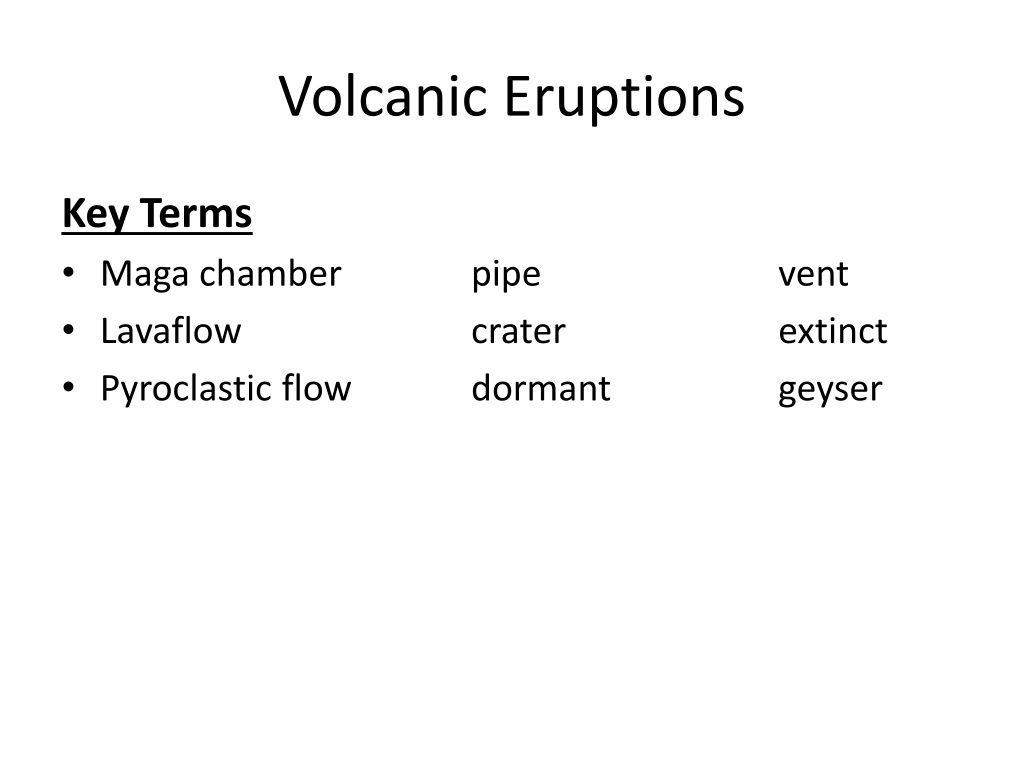

![Read⚡ebook✔[PDF] Io After Galileo: A New View of Jupiter's Volcanic Moon (Sprin](/thumb/21612/read-ebook-pdf-io-after-galileo-a-new-view-of-jupiter-s-volcanic-moon-sprin.jpg)
